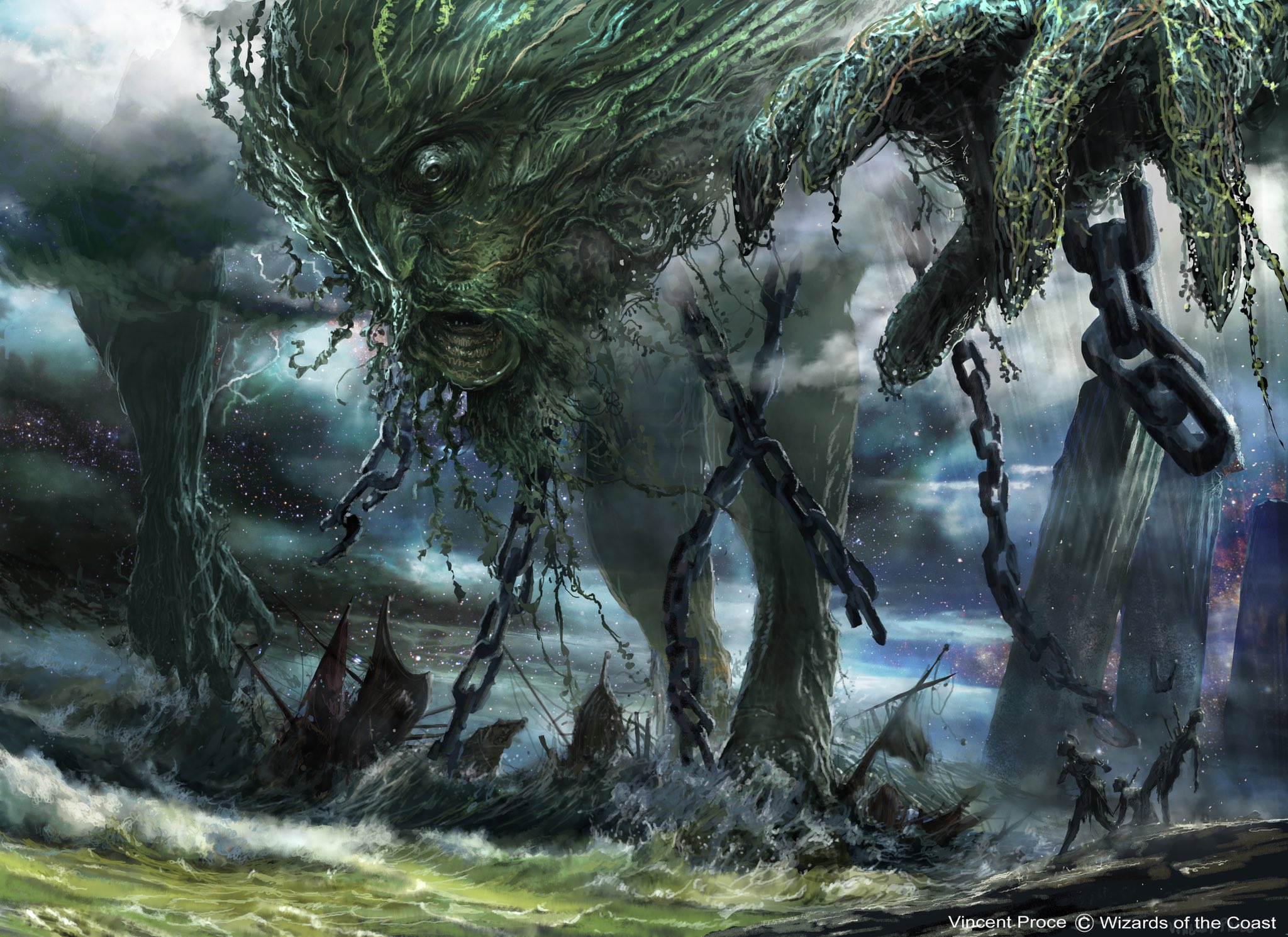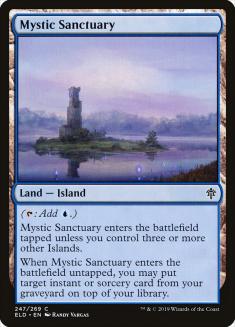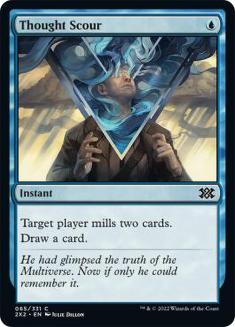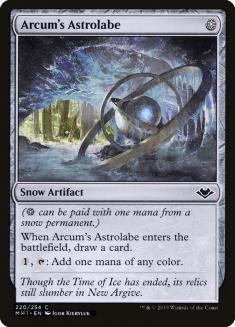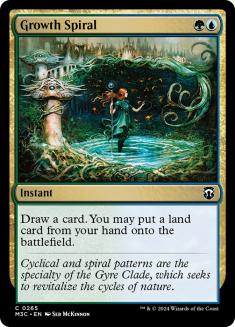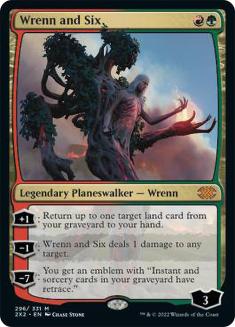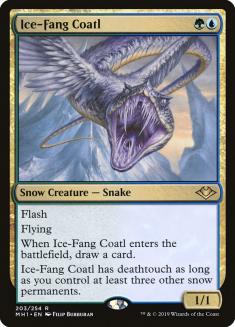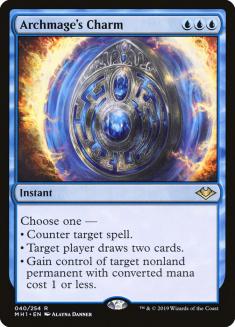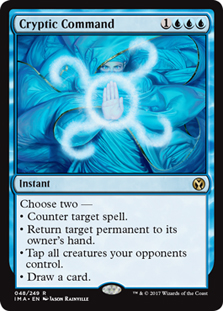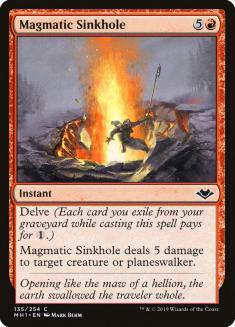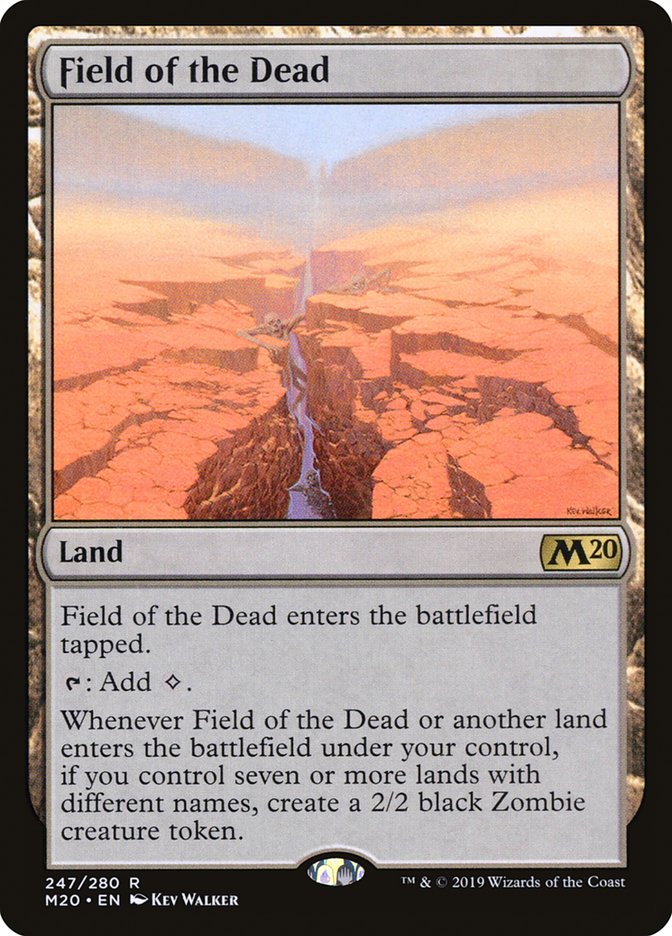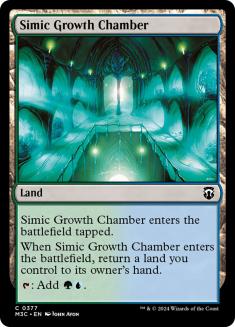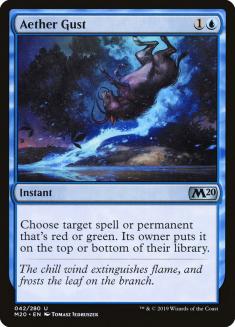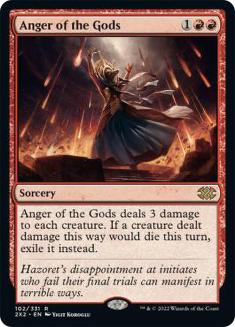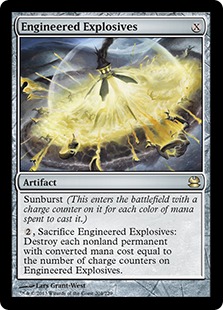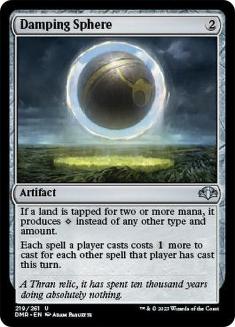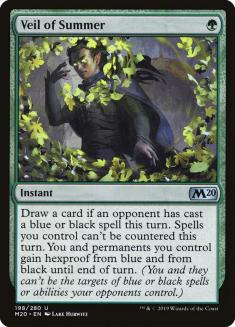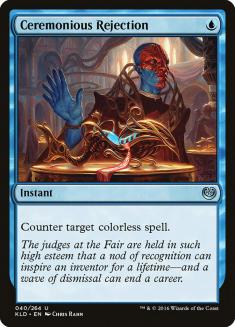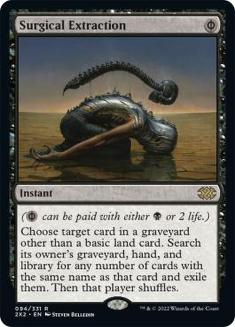I’ve been having a blast playing Modern lately. I’m working full-time on Magic at Wizards of the Coast (only for four weeks, and I’m just over one week in), and I’ve still gone to play an FNM despite needing to ask around for a ride to the tournament from Wizards and then travel over an hour on public transportation to get home afterward just because I like playing this deck so much. Is it the best deck in Modern? I don’t know, I’m not grinding Magic Online, I’m just playing local tournaments, but it’s a real delight.
So what is this deck and why is it so fun?
Well, it’s easy to tell you what it is. We can start with a decklist:
Creatures (6)
Planeswalkers (2)
Lands (27)
Spells (25)

The most important thing I’ve learned is that Mystic Sanctuary allows you to play very high land counts without flooding because you get to control so many of your draw steps. Playing additional lands allows me to take advantage of Growth Spiral and Uro, Titan of Nature’s Wrath to get ahead on mana and trigger Mystic Sanctuary more quickly, allowing me to replace Snapcaster Mage entirely.
This deck uses Uro extremely well, since it has twelve fetchlands, Thought Scour, and mostly instants that replace themselves, so it’s easy to find it and fuel the escape. The combination of Uro’s lifegain and Lightning Bolts make it pretty easy to stay alive against aggressive decks, and the Archmage’s Charms and Cryptic Commands combine with your substantial mana advantage to go over the top of interactive decks. Counterspells are traditionally good against ramp strategies, but the same hasn’t been true for the most successful deck in Modern at the moment, Amulet Titan. Fortunately, I have a plan for that!
In Game 1, things can get tricky because you can’t really stop Cavern of Souls with Primeval Titan; however, I have been able to just go bigger faster than them by stealing their Amulet of Vigor (mostly just to keep it away from them), using my own ramp spells, and bouncing their bouncelands with Cryptic Command. If you can get Uro down before they get Primeval Titan, you can potentially run away with the game from there.
After sideboarding, things get a lot better, because you get Aether Gust, which can stop a Primeval Titan from resolving despite Cavern of Souls or Veil of Summer. They can try again next turn, but thanks to your twelve fetchlands, Mystic Sanctuaries, and wealth of cantrips, that’s unlikely to work any better. If you’re not making any progress either, this won’t get you anywhere, but with Archmage’s Charm, Wrenn and Six, and Uro, you’ll often be able to spare a draw step and some mana while advancing your gameplan.
So, that’s the big picture. Now let’s get into the details.
Card Choices
This is the best cantrip because it’s an instant, so it allows you to immediately draw something when you need it if you combine it with Mystic Sanctuary (though you’ll have to target your opponent), but this is also the best card selection spell because it fills your graveyard to allow Mystic Sanctuary to function as Mystical Tutor, and also finds and fuels Uro. As a small added bonus, it’s also good with Wrenn and Six.
The mana requirements in this deck are pretty intense. You want early red, you want your first three lands to be Islands (and then you want to search for more Island), and you want two green for Uro. You can do all this with fetchlands, but Arcum’s Astrolabe makes it much less painful, and makes you much less vulnerable to Blood Moon.
Temur Uro is mostly a Simic deck splashing removal. Wrenn and Six is very good, but not technically necessary. If you think Path to Exile or Fatal Push lines up better in the format, you could probably replace red with another color. I like Lightning Bolt because I think it’s the best removal spell at answering early creatures and planeswalkers without giving your opponent anything, and I have Cryptic Command for bigger things. Still, this is really a flex slot in the deck, though I definitely want to play removal, and again, I don’t want to understand how much of a draw Wrenn and Six is.
Growth Spiral has really impressed me here. Getting to turn on Mystic Sanctuary and Cryptic Command a turn early is really important, but it’s best with Wrenn and Six. When you have Wrenn and Six, you keep playing the same lands over and over, so other lands just get clogged in your hand. With Growth Spiral, you can get those lands onto the battlefield. When I have Wrenn and Six, I’ll frequently use Mystic Sanctuary to get back Growth Spiral to keep building my mana advantage in the mid-game.
I just touched on how this plays well with Growth Spiral, and it’s the same with Uro. Thanks to Cryptic Command, Archmage’s Charm, and Mystic Sanctuary, you can generally keep spending all your mana doing stuff, so drawing an extra land every turn to cast more spells is great. Further, this deck has the absolute best Wrenn and Six emblems, since you have so much mana and the best spells to cast over and over. I’m playing two at the moment because I want to be very cautious about having multiple copies of cards that don’t work well in multiples, especially because I draw so many cards, but it’s been very good. I know I want at least two, but three or four could easily be better.
These are definitely the most flexible slots in the deck, as all the instants feel really important. I like Ice-Fang Coatl because it pairs well with red removal in that it’s good at answering large creatures, and I like having a productive card I can play to the battlefield after holding up mana to potentially counter something. Ice-Fang Coatl is a great card and I love it in the deck, but Wrenn and Six and Tireless Tracker are also worthy considerations for this space.
While Mystic Sanctuary is the card the deck is really built around, Uro is, for lack of a better way to put it, “what the deck does.” Most removal is horrible against Uro, and if your opponent uses Path to Exile, you’re happy to get another land and find another Uro later on. This card is absolutely necessary to compete against ramp decks and other opponents where you need to end the game at some point, but it’s also the best card against burn. If this deck is great, it’s because of the strength of Uro.
I absolutely love this card. It just does it all, and it’s really hard for me to get away from playing four of these. It’s the perfect card with Mystic Sanctuary, since you can safely return it when you don’t know what your opponent’s going to do to have a counter ready, but also just cycle through it to get ahead if they don’t do anything, unlike Cryptic Command, which only really generates value reactively.
Cryptic Command does everything.
Your graveyard is pretty heavily taxed by Uro, but you’re also great at filling it, and it’s good to have a card that can answer larger creatures and planeswalkers than Lightning Bolt can kill.
It’s nice to have this to close the door on a game, especially if your opponent’s exiling your Uros. If I wanted to get better at ending the game, I could add an Hour of Promise to find this or a second copy (but with Hour I could mill it with Thought Scour and then grab it with Mystic Sanctuary), but for the most part, I think my late-game is strong enough that one copy can get the job done.
This is literally the point of the deck. I could see playing a fourth copy, and I definitely wouldn’t cut the third.
This lets you rebuy your Mystic Sanctuaries and ensures that you won’t miss land drops while you’re ramping. I’ve also used it with Growth Spiral to protect my lands. It’s also not that rare to end up with an Amulet of Vigor under your control for some nice added value.
I think it’s worth playing a non-snow Island to diversify land names for Field of the Dead, which can be tricky to turn on since you’ll often have multiple Mystic Sanctuaries, and there are enough snow sources for Arcum’s Astrolabe anyway.
Sideboard Choices
This is the most important sideboard card. I used to think decks like this needed Alpine Moon, but this is better. The draw to the card is to answer Primeval Titan, but I’ve recently sided it in against Burn, Mono-Red Prowess, and Devoted Druid. It’s actually good against a huge portion of the field. A counterspell that can answer a resolved Eidolon of the Great Revel or Blood Moon for only two mana is awesome. Three copies is the absolute minimum. I’m very tempted to play the fourth.
Everything about this deck is perfect for Tireless Tracker. You play tons of lands and have lots of time to crack the Clues. This is a great way to diversify threats or increase proactivity, and an entirely reasonable maindeck consideration.
I think it’s pretty important to have some kind of sweeper and it’s nice that this exiles since I’m pretty low on graveyard hate. Also, it’s best to play as many cards as possible that Mystic Sanctuary can return to get the most value out of them.
I just always like to have access to this if my deck has a lot of colors of mana. It’s a very strong card. It’s certainly not necessary though, since you definitely get less value out of artifacts than instants or sorceries.
I don’t know that this is the best hate available for big mana decks here, but it is good against them and I like that it hedges against Underworld Breach, which I feel like the world could figure out how to break at any time.
There are remarkably few people playing decks where this card is good, but it’s so amazing at what it does that I’d hate to be caught without it.
I haven’t seen a lot of Green Tron or Eldrazi Tron lately, but like with Veil of Summer, this is so good where it’s good, especially since I don’t have two-mana counterspells, that I want to be ready.
Graveyard strategies aren’t very popular either, but again, I want to be ready and this is the best instant to answer graveyard cards.
Sideboarding Strategy
For the most part, you’re just trying to control the efficiency VS power of your deck. Against fast decks, you’ll probably need to trim the slower blue cards, against creatureless decks, you can cut Lightning Bolt, Magmatic Sinkhole, and Ice-Fang Coatl. If your opponent can counter your Cryptic Command, there’s a good chance you want to trim some, as it’s often not worth exposing yourself to the tempo loss. The sideboard is full of low numbers of high-impact cards because you really don’t want to sideboard very much, but you get a ton of value out of the first copy of an effective instant you draw because you can use it several times with Mystic Sanctuary.
I think the maindeck is very tight and I wouldn’t change much beyond choosing the best splash color and maybe replacing Ice-Fang Coatls. You could potentially trim a Cryptic Command or something, but there’s a very good chance it would just make the deck worse.
The sideboard on the other hand is extremely flexible and easy to tune to an expected metagame. A card like Weather the Storm or Life Goes On against Burn or Sudden Shock against Infect could meaningfully impact your win rate.
Basic Play Pattern
For the most part, you just want to focus on staying alive and building up lands on the battlefield. Don’t be afraid to draw two cards with Archmage’s Charm, since you’ll almost certainly just get it back again with Mystic Sanctuary. Once you’re out of Mystic Sanctuaries, you might want to start being a little more conservative and building a hand full of counterspells. Getting Uro onto the battlefield is an easy way to transition to the end-game, but there’s no rush. If your opponent could potentially do something scary, you can just wait until you have enough mana to escape it and counter something. It shouldn’t take very long.
I generally cast Wrenn and Six before Growth Spiral, as gaining cards and loyalty is more important than getting more lands onto the battlefield. Wrenn and Six generates value over time, while Growth Spiral is a one-time effect and you can just catch up the next turn. You’ll have gotten to tap the land one less time when all’s said and done, but a Wrenn activation is worth a lot more than a mana by default.
Be careful about which lands you’re fetching. I really like to avoid getting Mountain or Forest before I have three Islands if I can help it, and remember to try to plan for double green on four mana if you might want to escape Uro before you play your fifth land. Also, be careful about lands that don’t tap for blue even in the mid- to late-game. Cryptic Command and Archmage’s Charm are incredibly color-intensive and only having five blue instead of six when you need to have two counters available can lose you a game.
This is the exact kind of deck I love to play: the kind that’s really good at playing with its food and just generating an incredible battlefield advantage without actually ending the game, especially if you play it like I do and don’t really prioritize protecting Uro.
This deck has felt really strong and well-positioned to me, and I’d absolutely play it in a Modern Grand Prix or Open if I had one to play in coming up. If any of this sounds like your kind of thing, I strongly recommend it.

